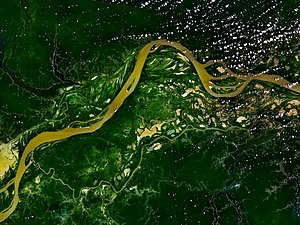After reaching the lowest Amazon deforestation rate ever recorded, Brazil faces a its next hurdle: how to maximize the increasing resolution of satellite images to monitor small-scale forest destruction.
Brazil’s clear-cut deforestation rate led the world just five years ago. And between 1995 and 2006 an average of 19,497 square kilometers of forest was cleared in the Amazon annually, or an area equal to that covered by roughly 3.5 million American football fields.*
Starting in 2006, however, this trend reversed, and the figures started plummeting. Within four years the Brazilian government recorded a 60 percent drop in the nation’s annual rate of deforestation; in 2010 it reached its lowest level since 1988. The 2010 figure—6,498 square kilometers—raised hopes that Brazil would fulfill the pledge in its 2009 National Law on Climate Change to reduce Amazon rainforest destruction 80 percent by 2020.
Evidence now suggests that continued reductions in deforestation will be hard to come by. Why? Because clear-cutters have figured out how to defeat detection efforts by targeting small parcels that are less likely to be observed by the satellites currently in use to monitor illegal logging. “The challenge has become much more difficult,” says engineer Gilberto Camara, head of INPE, Brazil’s National Institute for Space Research.
Camara has repeatedly noted that patterns of Amazon deforestation have changed dramatically in recent years. In 2002 35 percent of the total area cleared of trees consisted of land swaths smaller than 0.5 square kilometer, whereas by 2010, the contribution of these small areas to the overall deforestation number increased to 80 percent. In other words, although the total number of felled trees was reduced, the smaller areas that are still being cleared have increased in number.
Smaller areas are more difficult for monitors to detect, but new space-based, remote-sensing technology can help—something Brazil is quite familiar with. Since the 1980s the country has relied on satellite images to measure environmental changes in the Amazon. In 2004 the Real-Time Deforestation Detection System (or DETER, after the name in Portuguese) came on line. Using daily imagery obtained via the MODIS (Moderate-Resolution Imaging Spectroradiometer) instruments on both NASA’s Terra and Aqua satellites, and combining that with data collected by the WFI (Wide-Field Imager) sensor on board the China–Brazil Earth Resources, or CBERS, satellite, INPE manages to issue every fortnight an assessment of areas at risk for deforestation.
Those bi-weekly alerts have guided the nation’s environmental police, and enforcement operations have doubled in the region in the past five years. Farmers and loggers cutting down areas as large as 2,000 hectares have received hefty fines, and their properties, machinery, timber and/or cattle have been confiscated. “No one dares to chop down large areas anymore because they know they will get caught,” says geologist and geographic information system (GIS) researcher Britaldo Soares at the Federal University of Minas Gerais’s Center for Remote Sensing. The result, however, is that deforestation has become much more diffuse and difficult to halt.
The smaller parcels also mean that farmers who engage in slash-and-burn subsistence agriculture now conduct much of the clearing, rather than industrial-scale outfits. Meanwhile, the “bad guys”—big cattle ranchers and loggers—know that satellites’ optical instruments rarely detect small patches of destruction or even see them at all beneath cloud cover. So, loggers are adapting their methods to avoid detection.
Camara says that the country now needs a new real-time system with 20 times more spatial resolution than the current one to spot areas down to 0.2 square kilometer. “We are missing a great deal of degradation going under the canopy,” he explains. Both sensors used today—Modis and WFI—resolve objects down to 250 meters across. The ideal would be something between 20 and 70 meters. Some existing satellite technology can provide images with such resolution, but they take longer to obtain (Landsat provides images every 16 days) and are too expensive, because they are commercial ventures.
Related articles
- Rare Amazon Tribe Nearly Extinct from Deforestation (treehugger.com)
- Brazil banks ‘fund deforestation’ (bbc.co.uk)
- Amazon images: Pictures of Awá tribe at work and play (dailymail.co.uk)
- Monitoring deforestation. (news.mongabay.com)
- Deforestation: Facts and Figures (somescientistsbelieve.wordpress.com)
- Rainforest activist asks for protection (guardian.co.uk)
- Amazon facing new threat: Agent Orange (guardian.co.uk)
- Move To The City, Save The Rainforest (fastcompany.com)









